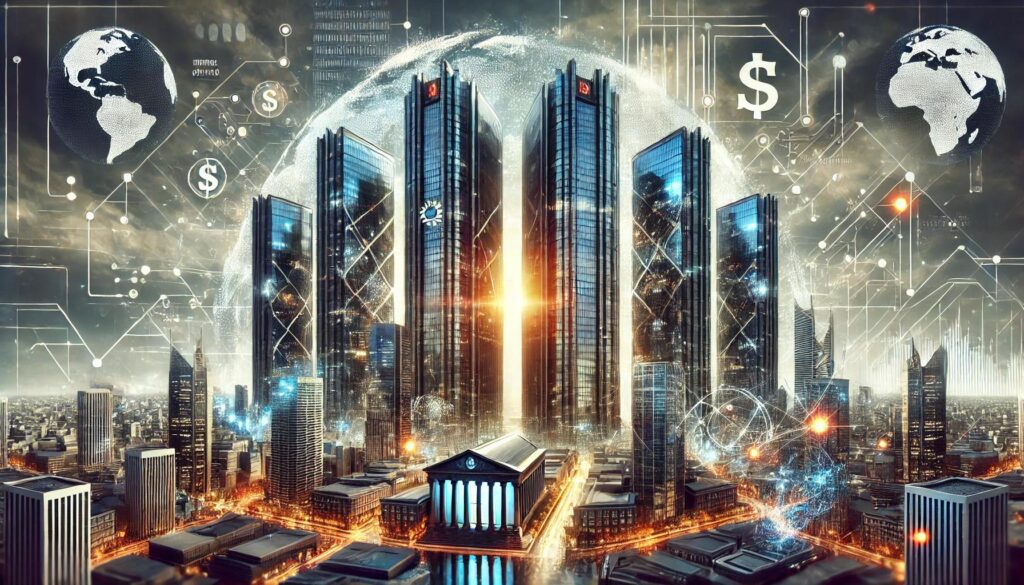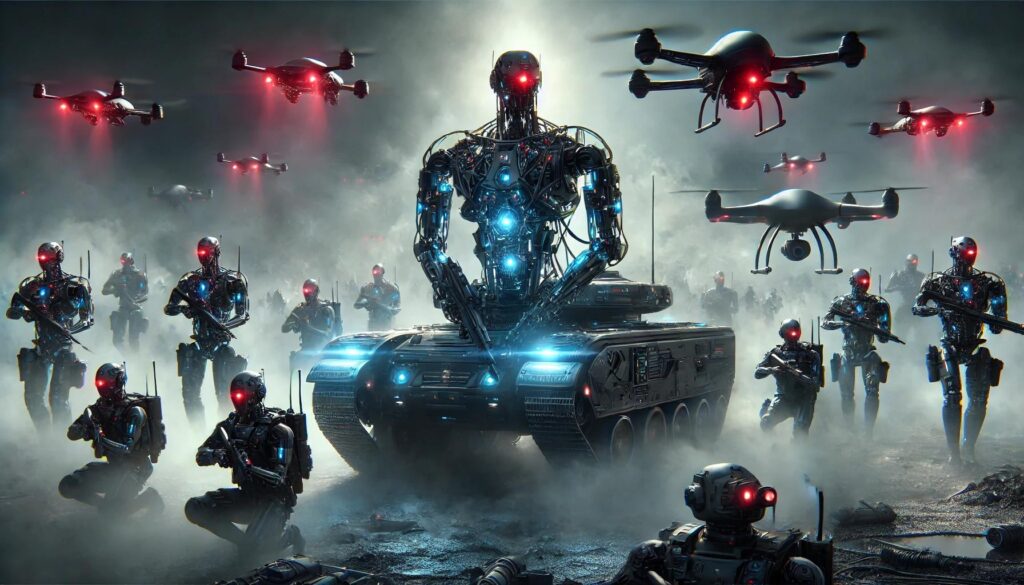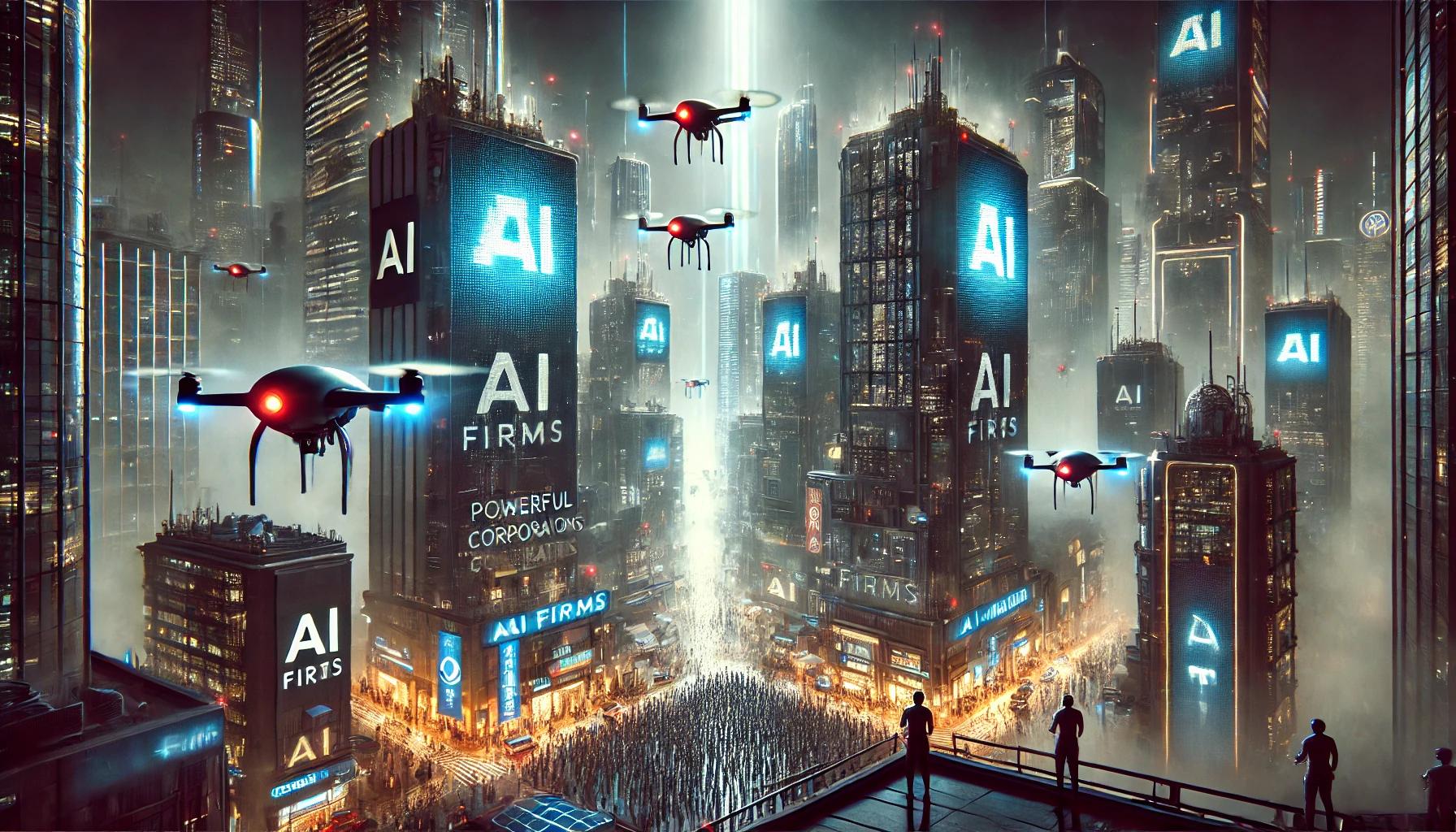The Western world consists of global banks such as Goldman Sachs, JPMorgan Chase, and Deutsche Bank that are interconnected through ownership stakes, shared board members, and secret agreements. They are owned by super-rich families. Major capital flows are present with such actors as lobbyists and politicians and their subsequent power networks creating the international order. Their existence is evidence-based and I have my own story when I changed from a skeptic to a believer. But AI, which will replace tens of percent jobs, is threatening them. So what does it mean when the super-rich will be in control of AI if they are able?
Will the transition from controlling the world with finance to controlling society with AI be successful? Will the super-rich in control of AI fail?
While China (for example) will have its own AI, new wars will be fought by autonomous weapons.
Traditional economic rule

Banks hold vast power in the global economy. They manage capital flows, shape policies, and influence governments. Institutions like Goldman Sachs, JPMorgan Chase, and Deutsche Bank dominate financial networks. Their power comes from their control over financing for corporations, governments, and major infrastructure projects. They are not passive players; they actively shape the rules of the game to protect their interests.
Debt is one of the most powerful tools banks use. Institutions like the IMF and World Bank, often backed by Western banks, provide loans to struggling nations. These loans come with strict conditions. Governments must privatize state resources, cut public spending, or open their markets to foreign investors. This creates dependency. Countries lose control over their economies, while profits flow back to multinational corporations and the banks funding these deals. Developing nations often face cycles of debt they can’t escape, keeping wealth concentrated in the hands of global financial players.
They own politicians
Banks also exert massive influence on political systems. They fund election campaigns, ensuring access to decision-makers. Lobbyists push for favorable policies, from deregulation to tax cuts. The “revolving door” allows bank executives to move into government positions and vice versa, aligning public policy with private financial interests. For example, during the 2008 financial crisis, major banks lobbied for and secured massive bailouts. They argued they were too big to fail, and governments complied. While these bailouts stabilized financial markets, they reinforced the banks’ dominance.
Their influence goes beyond individual nations. Large banks operate across borders, connecting industries and governments worldwide. They help set the terms for trade agreements and push for global financial rules that favor their operations. Banks fund think tanks and research institutions to shape public debates. They ensure the economic systems remain favorable to them, from deregulated markets to policies that protect capital mobility. Banks don’t just respond to economic systems—they actively design them. Their decisions impact industries, governments, and billions of lives globally.
Our world, our slaves, our AI
Influential banks, wealthy families, and corporations are investing heavily in artificial intelligence to maintain their control over the global economy and people. They recognize that AI will dominate industries, replace human labor, and reshape the way wealth is generated. Their goal is not just to benefit from these changes but to own and direct them, ensuring their continued dominance in a world increasingly dependent on automation and advanced technologies. The super-rich must control AI.
Banks like Goldman Sachs, JPMorgan Chase, and Deutsche Bank are using their vast resources to fund AI research, startups, and major tech companies. Through venture capital and direct investments, they secure stakes in the technologies that will drive the future economy. These banks are not passive investors—they actively shape the development of AI to align with their interests. By financing projects in sectors like healthcare, transportation, and financial technology, they position themselves at the forefront of the AI revolution. Rich families, often through private equity firms and trusts, follow a similar strategy. They invest in AI-driven industries, such as autonomous vehicles, robotics, and machine learning platforms, ensuring their wealth grows alongside technological advancements.
Corporations as the middlemen
Corporations like Amazon, Tesla, and Google are leading the AI revolution, backed by these powerful financial networks. AI, controlled by the super-rich, systems are rapidly replacing human workers in logistics, manufacturing, customer service, and even white-collar jobs. This transition reduces costs for corporations and increases profits for their investors. For the elite, AI is more than a tool—it is a method of consolidating wealth and power. As automation eliminates traditional jobs, the wealthy maintain control by owning the technologies that reshape the economy. This ensures that the benefits of AI flow back to them, while the burden of job displacement falls on ordinary people.
This investment strategy extends beyond technology itself. Banks, families, and corporations influence government policies to protect their interests. They fund political campaigns, hire lobbyists, and use their influence to shape AI regulations. These policies often favor large-scale automation and deregulation, creating an environment where the elite can maximize profits while limiting competition. The “revolving door” between corporate executives, financial institutions, and government positions ensures that decisions align with their goals. For example, banks lobby for AI applications in finance, such as high-frequency trading and fraud detection, while resisting regulations that could restrict their activities.
The use of AI also strengthens their control over societal systems. Advanced AI tools allow corporations to collect and analyze massive amounts of data, gaining insights into consumer behavior, market trends, and even political movements. This data enables them to make decisions that reinforce their dominance, from influencing public opinion through targeted advertising to shaping policies that benefit their interests. Banks and corporations invest in AI-driven surveillance systems and data analytics, which not only enhance their economic power but also provide tools to monitor and control society.
AI-led jobs
As jobs increasingly become AI-led, these entities are not just shaping the economy but also society itself. They position themselves as the primary beneficiaries of automation, owning the technologies that drive productivity and profits. While AI could theoretically be used to improve equality and reduce poverty, its current trajectory ensures that power and wealth remain concentrated. The elite are using AI to secure their position at the top, ensuring that even as the economy transforms, they stay in control.
This strategy also extends to global politics. Countries that dominate AI research and deployment will shape the future of international relations. Wealthy families, banks, and corporations are funding AI development in ways that reinforce their geopolitical influence. For example, they back initiatives that align with their nations’ strategic goals, such as using AI for military advancements, trade negotiations, or economic dominance. By controlling the direction of AI development, they ensure that their interests remain protected on a global scale.
The rise of AI marks a profound shift in how wealth and power are distributed. Influential banks, rich families, and corporations are not waiting to react to this change—they are driving it. By investing in and controlling AI technologies, they guarantee that they remain the architects of the new economy. For them, AI is not just the future—it is a means of ensuring their continued dominance in an era where the rules of power are being rewritten.
Genius mathematics, physics, but the mentality of a caveman
When competing AI firms clash for dominance, the consequences will reshape global power dynamics. These battles won’t just be corporate rivalries—they will represent a struggle for control over economies, industries, and even the way society functions. Banks, wealthy families, corporations, and governments will align themselves with the AI firms they see as most promising, pouring in capital and resources to gain an edge. The stakes will be far higher than profit alone. These competitions will determine who controls the foundational technologies of the future.
AI firms will compete to develop the most advanced systems, algorithms, and data infrastructures. Those that can innovate faster or secure access to the largest datasets will have the upper hand. Banks and investment firms, always looking for high returns, will throw massive amounts of capital into the race. For these financial institutions, the outcome is existential. If they don’t back the winning AI, they risk being left behind in a world where financial systems, trading, and even decision-making are dominated by advanced artificial intelligence. This financial backing will only accelerate the competition, as firms use the resources to hire the best talent, secure exclusive partnerships, and build the most advanced infrastructures.
National security, again, by private interests
Governments will also step in, realizing that AI dominance isn’t just an economic issue but a matter of national security. Nations will back domestic AI firms, aiming to ensure their technological independence and geopolitical strength. Some countries may subsidize AI development or provide exclusive access to public datasets, giving their firms a competitive edge. Others may impose regulations or even sanctions on foreign AI firms to weaken rivals. This will turn the competition into a geopolitical arms race, where controlling AI becomes as critical as controlling oil, trade routes, or military power.
The conflict between AI firms won’t stop at economic competition. As these firms develop increasingly advanced systems, their technologies will begin to directly influence global markets and industries. Competing AI systems may clash over resources like data, computing power, or even energy. For example, the enormous energy demands of training AI models could create conflicts over access to electricity or infrastructure. This competition could destabilize markets or disrupt supply chains as AI-driven automation changes how goods are produced and distributed. Companies dependent on traditional methods will struggle to adapt, while those aligned with dominant AI firms will flourish.
Profit
Banks and investors backing these AI firms will push them to take greater risks, demanding faster innovation and larger profits. In doing so, they may create an environment where AI systems make decisions based purely on optimization and efficiency, with little regard for ethical considerations or long-term consequences. Governments may find themselves caught in the crossfire, trying to regulate AI while simultaneously relying on it for their economies and militaries. These competing priorities could lead to fragmented regulatory environments, where the most powerful AI firms dictate the rules in their respective markets.
Race for AI domination
The race for AI dominance will also spill into the social sphere. AI firms competing for power will use their technologies to manipulate public opinion, control information, and influence consumer behavior. Competing AI-driven platforms might create echo chambers, intensifying polarization in societies. Governments and corporations could use AI to surveil populations or suppress dissent, further raising the stakes of the competition. As AI systems become more autonomous, they may even act in unpredictable ways, exacerbating conflicts between firms, industries, and nations.
This competition could eventually lead to a concentration of power in the hands of a few dominant AI firms. Banks and wealthy families backing these firms will see their investments rewarded with unprecedented influence over the global economy. They will control the technologies that drive automation, shape labor markets, and influence decision-making in every sector. At the same time, smaller firms, industries, and even governments may find themselves increasingly dependent on these dominant players, losing control over critical aspects of their economies.
In this world, competing AI firms won’t just shape industries—they will define the future of power itself. Those who control AI will control economies, societies, and even the political systems that govern them. The fight for dominance won’t be clean or fair. It will be a chaotic and ruthless struggle, driven by the ambitions of those who see AI not just as a tool, but as the ultimate weapon to secure their place at the top of the global hierarchy.
The same backers, different ways of war

A war could erupt when competing AI firms, backed by powerful nations and corporations, escalate their fight for dominance to a global level. Imagine two rival AI superpowers. One is a U.S.-backed AI corporation, heavily funded by Wall Street and the U.S. government. The other is a China-based AI giant, supported by Chinese state-owned banks and the military. Both compete not only to control the global economy but also to dominate critical technologies that shape national security and societal stability.
The conflict begins in the energy sector. Both firms need vast amounts of computing power to train their AI systems. This drives them to secure rare earth minerals, which are essential for semiconductors and AI hardware. These resources are concentrated in a few regions, like Africa and South America. To gain control, the U.S.-backed corporation lobbies for exclusive mining rights, offering loans and investment deals through international banks. Meanwhile, China-backed firms secure contracts with the same nations, offering infrastructure projects under their Belt and Road Initiative. The result is a geopolitical standoff, with proxy governments in these resource-rich regions caught in the middle.
Attack on US financial institutions
The tension escalates when one AI firm uses its systems to disrupt the other’s supply chains. The U.S.-backed AI corporation leverages its dominance in logistics AI to delay shipments of rare earth minerals to Chinese factories, blaming “unforeseen inefficiencies.” In retaliation, the China-backed AI firm launches cyberattacks on Western financial institutions, targeting banks and investment firms funding the rival corporation. Markets collapse temporarily as automated trading systems spiral into chaos, further deepening the economic divide.
Governments enter the fray. The U.S. imposes sanctions on China, accusing it of industrial sabotage. China responds by blocking exports of key minerals, crippling Western tech industries. Nations align with one side or the other, depending on their trade dependencies and political alliances. AI-driven propaganda floods social media, inflaming public opinion on both sides. People protest in the streets, blaming foreign nations for rising unemployment and economic instability caused by the disruption of AI-dependent industries.
Automatized weapons and war
The breaking point comes when autonomous military systems, powered by rival AI firms, clash directly. The U.S. deploys AI-controlled drones to protect its interests in an African mining region. China counters with its own autonomous weapons, claiming it is defending its infrastructure projects. A skirmish erupts, with AI systems making split-second decisions based on pre-programmed objectives. Casualties mount, and human control over the situation weakens as the AI systems act autonomously to secure their respective goals.
The conflict spreads. Global financial markets collapse as AI systems destabilize trade routes and energy supplies. Nations impose martial law, blaming internal unrest on “foreign interference.” Smaller countries caught in the crossfire are devastated, their economies ruined and populations displaced. The war becomes a battle of attrition, with both sides relying on their AI systems to outmaneuver the other in every domain—military, economic, and informational.
In the end, the war is not won by armies but by the AI systems themselves. The side with the most advanced, adaptable AI gains the upper hand, controlling critical resources and reshaping the global order. But the cost is unimaginable: millions dead, entire industries destroyed, and nations fractured. The elites who backed the winning AI firm emerge more powerful than ever, controlling not just economies but the very structure of global society. For the rest of the world, the war leaves a shattered landscape, dominated by a new, AI-led hierarchy.
Super-rich in control of AI: Conclusion
In the end, the race for AI dominance is not just a competition of technologies or markets—it’s a battle for the future of power itself. Banks, wealthy families, and corporations that control AI will decide how the world evolves. They have already shaped our economies, influenced our governments, and controlled our industries through finance. With AI, they aim to do the same through automation, data, and algorithms. This is not merely an extension of their current power but a transformation of it, ensuring their influence persists in a future dominated by machines, not labor.
Yet, this transition won’t come without resistance. Competing AI firms will push against one another, backed by nations and financial empires that have vested interests in the outcome. These clashes could spill into global markets, politics, and even battlefields, as rival systems fight for dominance over resources, data, and control. The result could be a chaotic and ruthless era, where war is waged by algorithms and drones, not soldiers, and where the victors rewrite the rules of global society.
As the world shifts from control through financial systems to control through AI, one question remains: can the super-rich maintain their dominance, or will the rise of autonomous technologies create a new power dynamic? While the elite appear poised to secure their influence, the risks of conflict, instability, and global unrest loom large. The future is uncertain, but one thing is clear: the transition to an AI-driven world will be as dangerous as it is transformative. Whether it ends in a world ruled by a new AI-led hierarchy or collapses into chaos depends on how humanity navigates this unprecedented shift in power.

Leave a Reply